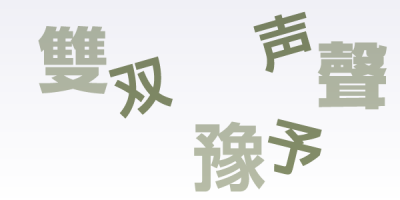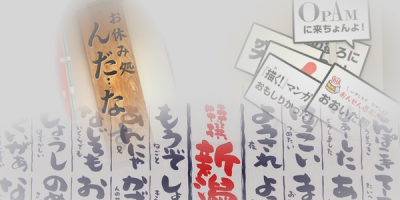Why think about characters? So far, I have explained my reasons from the point of view of Japanese language instruction and linguistic research (parts 98, 99). Finally, I would like to add the perspective of communications research, although it overlaps in places with linguistic research.
Consider a conversation between an adult and a child. Suppose the child stammers: “Because, uhh…” The adult responds by throwing the kid a lifeline, “Well, I guess we can skip the next Children’s Club meeting,” which the child immediately agrees to.
The child’s halting speech, while not very fluent, was successful in that the child’s way of speaking actually prompted the adult to lend assistance -this might be one interpretation of the situation. (Or rather is, in fact, the interpretation that would likely be made.) While this interpretation is true from one perspective, it is not necessarily always so. Perhaps the child had no intention of calling on the adult to lend assistance, but was simply confused and couldn’t spit out the words. Suppose that after this conversation he had killed himself, leaving behind a note that said: “I can’t go on because I can’t communicate. Forgive me.” What then of the interpretation that the child was successful in prompting the adult to lend assistance?

When a parent picks up a baby because it is about to toddle into danger, that baby does not (generally) secretly flash a tiny victory sign. Seeing intent where it does not necessarily exist and attributing “goal attainment” to unconscious behavior could quite possibly lead us to always view the various things which occur during communication (e.g. toddling and halting speech) as successes. In fact, many people are far from successful in their communication, and become worried and withdrawn, or even die, because of communication. Even if things don’t go that far, there are more than a few people who feel that nothing is more frightening or depressing than having to communicate with others.
Rather than seeing never-ending success among the participants in communication, it is necessary to focus on a realistic image of the speaker, not necessarily in conjunction with intent, in order to grasp real “fortune” and “misfortune.” For example, “misfortune” for the widow Yoshie Sasaki in Shiroi Kyotou (1969) and Mrs. Tagawa in Aru Onna (1911–1913) was falling from a position of “high rank” in a short period of time, and seeing people of “low rank” behave as their superiors, but not being able to acknowledge this fact, leading them to become confused and resentful. This was a stroke of “fortune,” in the form of a new-found “high rank” for the scornful vendor Nomura and Youko Satsuki respectively (parts 49–52). Although these are not very eloquent examples, they illustrate how we touched on “fortune” and “misfortune” in communication by considering character in this series.
As for other experiments in trying to grasp our “fortune” and “misfortune” in communication from the perspective of character, one could cite SENUMA Fumiaki’s Kyara Ron (Character Theory STUDIO CELLO, 2007) and AIHARA Hiroyuki’s Kyara-ka suru Nippon (“The Characterization of Japan,” Kodansha Ltd., 2007). However, as the theories in these works also encompass the prolongation of the Koizumi administration and the problem of truancy in schools, they deal more with current events in Japan and focus on the communication of young people. We looked at how the young man and woman in Dazai Osamu’s Haru no Kareha (1946) affected the accents of the “elderly,” saying “Anata no niisan wa, majime ja kara noo” and “Anata no okusan datte, majime ja kara noo” (“your elder brother is so serious,” “well, your wife is quite serious too”) in play. In this series, I have said that “we have been doing this sort of thing since long ago,” (part 10). I have tried to explain “communication,” and furthermore “language” in a form that is not limited to “recent times” or “youth,” and thus, from the beginning, have tried to use topics other than these in my explanations.
Using different topics, naturally, produces different ideas regarding “character.” For example, in ITO Go’s Tezuka Izu Deddo: Hirakareta Manga Hyoogenron he (Tezuka is Dead: Towards an Expanded Theory of the Language of Manga, NTT, 2005) introduced in the aforementioned work by Mr. Aihara, “Character” and “kyara” are categorized separately within the language of manga. This was probably because Ito judged that separating the two would be effective with respect to his theory of manga language. Also, Senuma’s use of the term “kyara” as a thing separate from “character,” “identity,” and “role” is probably due to the fact that he found it effective in discussing interpersonal relationships and communication among today’s youth. Similarly, while I do not make a distinction between “character” and “kyara,” my emphasis on the differences between “style” and “persona” stems from the fact that this is an effective method for discussing the language and communication of the Japanese-speaking community. It is only natural that each theoretician has a unique definition of “character (kyara)” that corresponds with what they want discuss.
Of course, considering various unified theories of “character (kyara)” is extremely fun for me. In considering the language of manga, Ito’s expansive idea that his theory “will open avenues connecting other expressive behaviors and academic fields with social phenomenon” is certainly not held by just Ito alone. However, in order to connect together “character (kyara)” theories in a way that transcends academic field, I need to first clarify my own theory of “character (kyara)” with respect to the other “character (kyara)” theories to which it should be linked.
Language and memory are not expected to change, unlike style, which can be freely altered to fit the person to whom one is speaking. Thus, if they do change, the observer is quickly lead to any number of conclusions about the speaker—“this person has been deceiving me,” “this person crumbles in the face of a strong adversary,” “this person is completely different around her lover” etc.—making both the observed and observer uncomfortable. However, it is not as fundamental a thing as “persona”—so, how can we discuss (the fortune and misfortune of) the language and communication of the Japanese-speaking community with this definition of “character (kyara).” I have tried to explain this as concretely as possible in this series.
I believe that ultimately the definition of “character (kyara)” we have given here can be combined with “style” and “persona,” and regrouped from the socio-psychological perspective of “attribution.” However, I do not currently have the wherewithal to embark on such an experiment. So, in closing I will say that in this series in grasping the variety of language produced by single speakers and fortune and misfortune in communication within the Japanese-speaking community, there are limits to just using “style” and “persona.” I will consider the goal of my essays fulfilled if the reader is satisfied on this point.
Thank you for staying with this series for so long.
* * *
Disclaimer: For the sake of consistency, I have quoted the word “kyarakutaa” from reference materials as “kyarakuta.” Please note that, in deference to understandability, in places I have referred to what should, more rigorously, be called “persons whose native language is Japanese” and “learners whose native language is not Japanese” as “Japanese” and “foreigners.” I have used as character names words which have discriminatory nuances, such as “okama,” “gaijin” and “oyaji”(1) as I deemed it necessary to illuminate disciminatory tendencies when considering character; it is not my intention to perpetuate discrimination. Thank you for your understanding.
* * *
* * *
Acknowledgements: thanks to the students of (in alphabetical order) my regular school Kobe University, my part-time workplace of Kwansei Gakuin University, and Kyoto University, for their valuable opinions. Furthermore Mayuko Ogino, Koichi Yamamoto, and Shino Yamada of Sanseido Publishing Co.,Ltd. helped greatly with uploading the essays and providing the illustrations. I would like to express my thanks to them here. These essays partially resulted from research performed through the Japan Society for the Promotion of Science Grants-in-Aid for Scientific Research: Basic Research (A) Jinbutsuzoo ni oojita Onsee Bunpoo (Spoken Grammar in Response to Portraits, Grant No. 19202013, Research Representative: SADANOBU Toshiyuki), Basic Research (B) Yakuwarigo no Rironteki Kiban ni Kansuru Sougouteki Kenkyuu (Comprehensive Research on the Theoretical Basis of Role Language, Grant No. 19329969 Research Representative: KINSUI Satoshi).









(1) Slang for transgendered/transsexual, foreigner, and middle-aged man respectively.